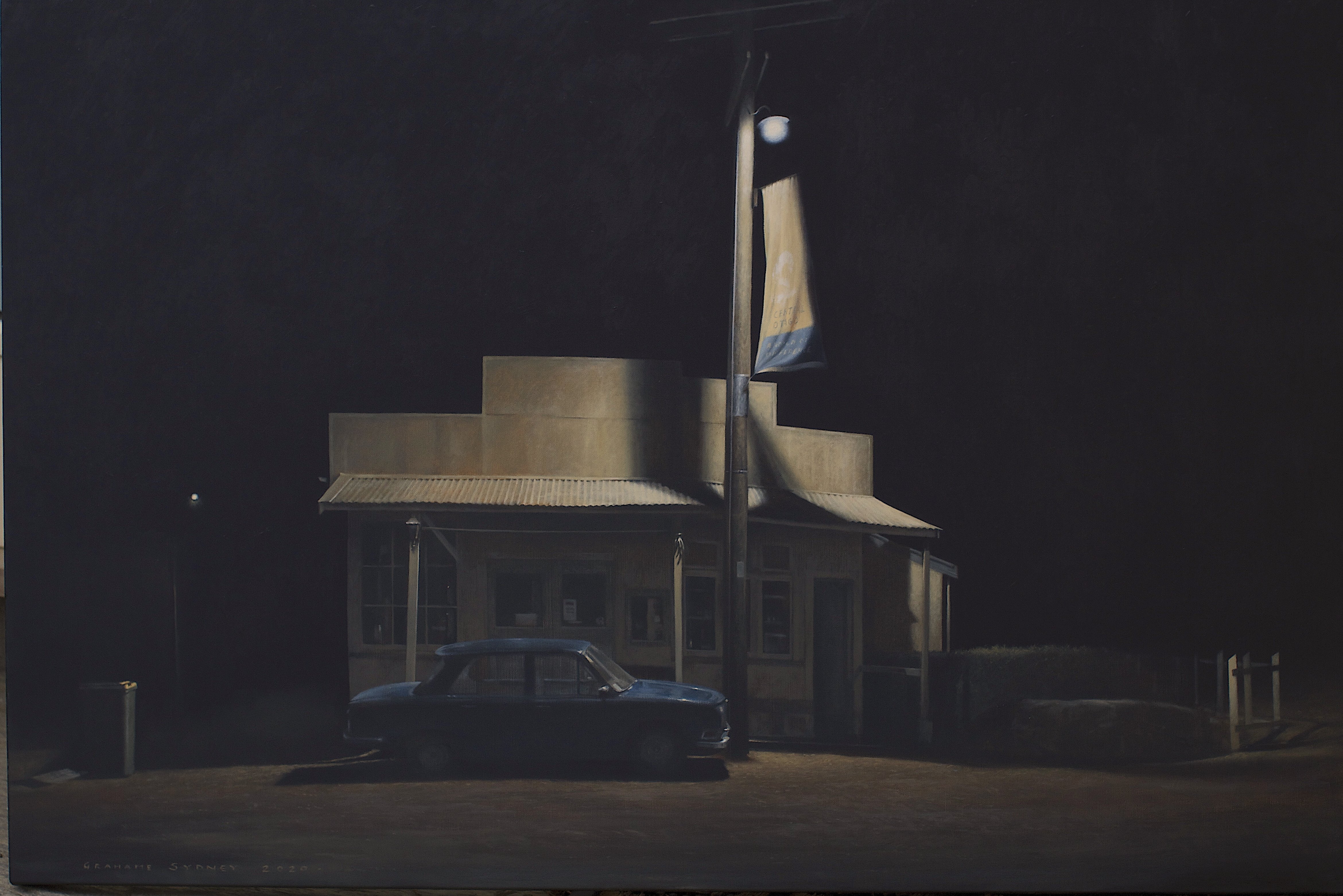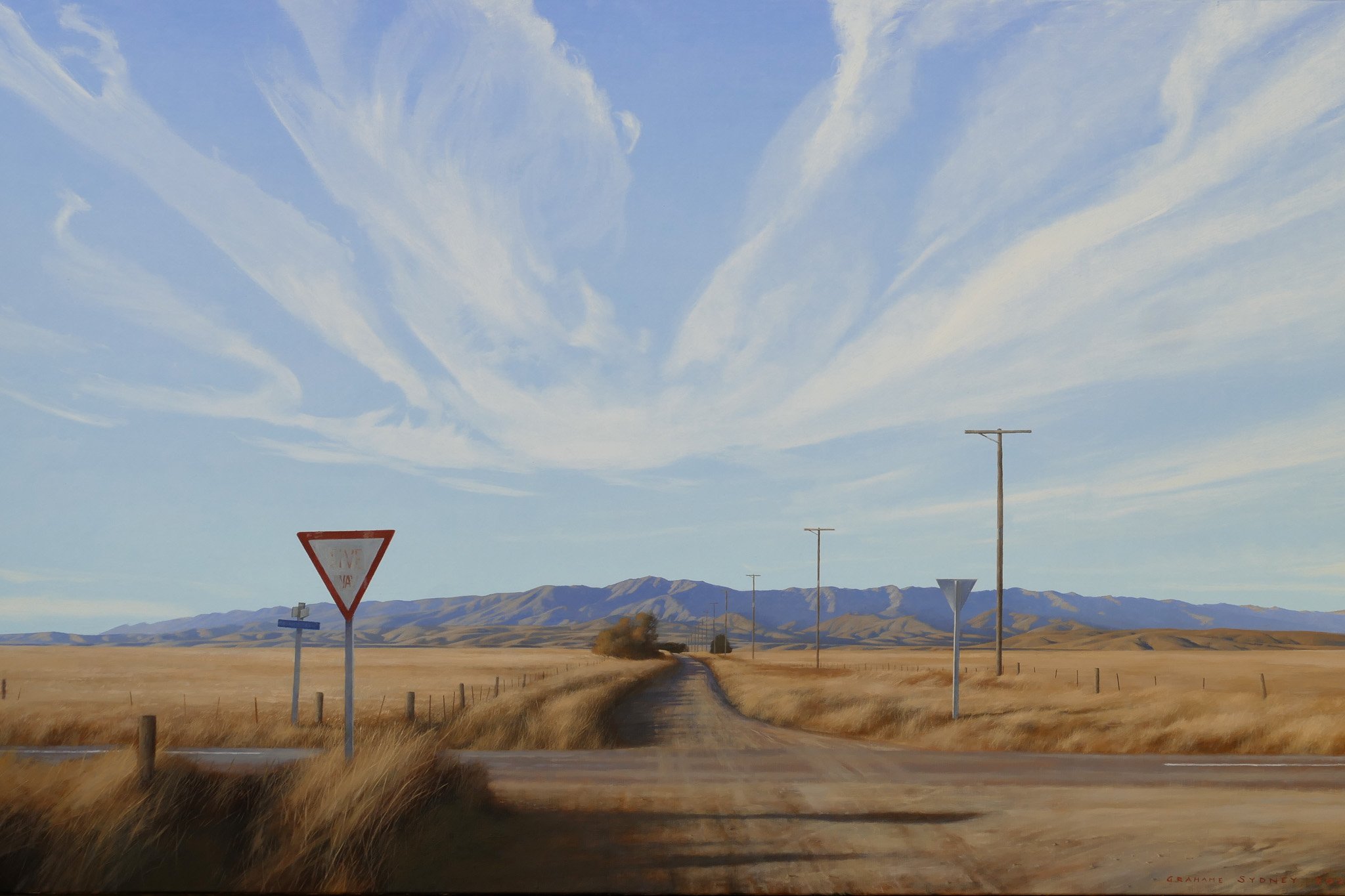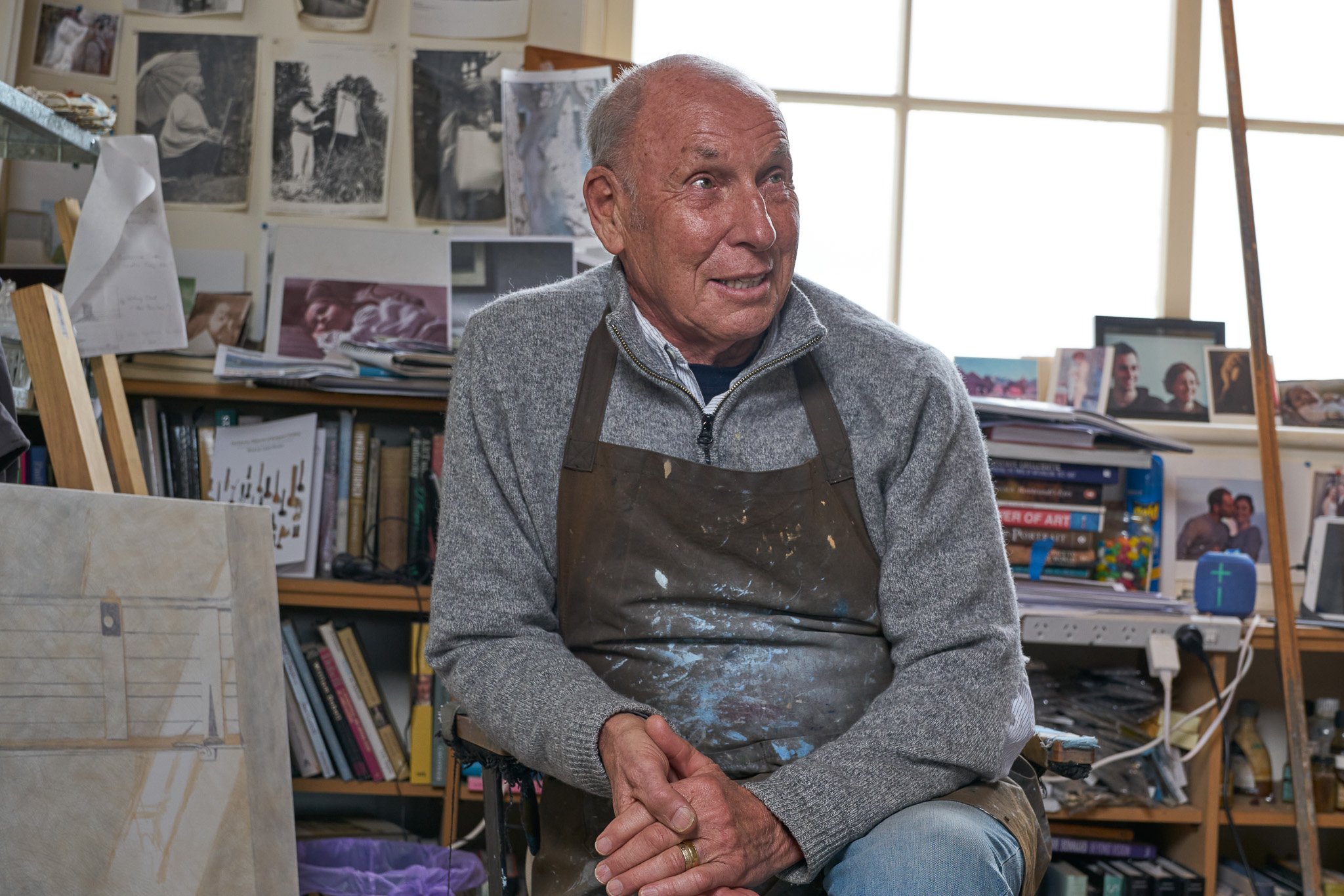
The Beautiful Lie
Living Magazine
“Every time I get something finished, I think it’s a miracle; I’ve gotten away with it,” he tells us in this exclusive interview.
His compositions in nature are immediately recognisable as his and only his. Atmospheric meditations on the vast, widescreen landscapes of his beloved Central Otago. They are at once filled with open space, yet also heavy with detail. Telegraph poles, lonely weather-beaten buildings, silent railway crossings and empty roads – if there is a human element to these large-scale vistas, it is usually decaying, somewhat futile and forgotten.
More recent works even serve to get rid of such clutter, leaving just the landscape itself, ever more isolated and untouched.
As a result, if you stand in that Central Otago landscape – with or without Sir Grahame Sydney by your side – you can’t help but be reminded of his work. His life’s work has become the definitive record of the region in egg tempera, watercolour and oil on linen.
To the north and south of his beautiful, book-filled home in the Cambrian Valley on the road to the hamlet of St. Bathans, lie two reoccurring geographic backdrops to many of Sydney’s works – the Dunstan and Hawkdun Ranges.
“The Hawkduns in particular have fascinated me for many years. I’ve never tired of them,” he says. “I love the symmetry of them. They’re a sort of unexpected, pleated range - ridge and valley, ridge and valley, ridge and valley - in a lovely repetitious triangular form.
“They catch the light amazingly. And in every season, they’re different. I find they provide a beautiful theatre for whatever the season is or whatever the light is doing.”
Having revisited the Hawkduns and other Central Otago landforms at many points over his career begs the question whether Sydney ever relies on photographs or sketchbooks when composing new works featuring familiar landmarks.
“I still take photos of these places because they’re important and fascinating to me. But I make a lot of it up too. You can fool anyone,” he smiles.
“Paintings don’t have to be honest. Even so-called realism doesn’t have to be honest: it’s just a term. If you want honesty, take a photograph, because a photograph doesn’t make any discerning judgements. It doesn’t leave anything out.”
Sydney says that, on the contrary, as an artist, making decisions and judgements about what remains inside the frame is all he does. It’s akin to a game the artist plays, ensuring whatever remains on the canvas is something memorable and effective. But not necessarily true.
“I select what I want to use. What’s going to be the most effective? What’s this about? What needs to remain and what can be left out? Different foreground, different sky, shift this from here to there. I make decisions about what I think the painting needs. And what I think it needs will be different to what you think it needs.
“It amuses me when people say ‘Oh, we’d love to know where you did that painting’. And all I can say is you’re just going to be disappointed, because they’re not reality. Although the paintings look realistic, they are the proverbial beautiful lie. They always have been. No one knows what was true and anyway, it actually doesn’t matter.”
What is irrefutable, however, is Sydney’s work ethic. It’s something that was instilled in him from an early age.
After the burgeoning artist returned to Dunedin in 1974, broke and depressed following an underwhelming overseas experience in England where he dreamed continual dreams about the Central Otago of his youth, his parents were endlessly supportive as he made a fresh attempt to find his artistic voice. But they insisted he treat his art like a job.
“The deal was, I could stay at home in my bedroom studio and live there for free, but I had to work dad’s hours. ‘This is not a hobby son,’ they’d say. ‘If it’s going to be a job, then you’re going to go to work at the same time as dad.’”


The ethos of the honest day’s work was something renowned artist and Hodgkins Fellow, Michael Smither, also drummed into the young Sydney.
“I’d left university by the time he was on the Hodgkins Fellowship, but I went back to see him often,” remembers Sydney.
“He used to turn up for work at quarter to nine, and by nine o’clock he had strapped on his butcher’s apron, and he was at work. He’d stop for morning tea and he’d stop for lunch. But it was a job to him. ’It’s business. You don’t get anywhere if you don’t work’, was his theory. He’d say ‘Don’t fool yourself into thinking you’re special because you’re not. Everyone else can do something that you can’t, so don’t forget it’. That’s a good way of looking at it actually. I’ve thought about that all my life.”
As a result, Sydney will spend many hours in his studio each day, interspersed with brisk dog walks across neighbouring lanes and fi elds. A chance to clear the head aft er such intense sessions? Not at all.
“I don’t think I’m ever free from thinking about what job I’m on. I’m always thinking about what’s going on in the painting,” he says. “What have I got to do? What isn’t right? How can I make this better? It’s like a cupboard in your brain that the door is shut on, but you know when you’re elsewhere there’s still always activity going on inside it.”
Beyond the canvas, however, there is undoubtably a business to being a successful artist. While Sydney has experienced plenty of success (along with lengthy struggles), he says the level-headedness required to learn how to survive in the arts and the art itself should never overlap.
“You never think of the business when you’re working. I don’t care what you’re doing. Whether you’re a photographer or a musician or a writer, you can’t allow the audience to intrude on what it is you want to do, because that’s an immediate diminishing of the thing that matters most.
“The moment you start thinking of the audience, you dilute your individuality. I believe you never follow an audience; you should lead it. And that’s a mistake a huge number of people make. They please the audience first. It can work, of course, you can survive that way. But it’s not where good art comes from.”
Good art of the Grahame Sydney kind comes latterly via oil on fabric. And in his formative years, watercolour along with a unique and ancient painting method: egg tempera. Before the 15th century Dutch discovery of oil paint, which could dry clear and stable on a vertical surface, all painting was done in egg tempera. Pigment is colour, but only becomes paint when it is glued up with a binder. The binder was necessary to stop the pigment from slipping down a vertical surface during the drying process. The yolk of an egg was discovered as the earliest binder to retain pigmentation.

When mixed with water, it becomes an emulsion. The oil particles are suspended opaque like milk. The water evaporates off and the oil particles stay behind, gluing up the pigment. The artist can apply as much water as desired, as long as there is the right amount of emulsion to pigment, with the colour of the yolk disappearing as it evaporates.
The technique doesn’t like a big brush, or a flood of water, with the artist getting the best results by building up a tapestry of small, woven strokes. The method, says Sydney, is more akin to drawing with a sharp pencil than painting with a brush.
“It suits somebody like me who likes to be patient and build things carefully. It gives you amazing control over textures and tone, shift s and edges; all the things that matter. It’s very painstaking, but it can also produce effects that are unproducible in any other medium.”
Regardless of the materials, Sydney’s technique is rewarding in its detail, but it is methodical in the extreme, requiring intense concentration and patience.
Compositions take months not weeks. Some might be set aside for entire seasons – years, even – before he returns to them.
“The paintings never go away,” he says. “To me, professionalism is finishing rather than abandoning. Disguising the labour, disguising the problems – these are the things you get good at over time.”
Utilising such precise, considered techniques – and with all of Sydney’s accumulated experience in mind – it almost seems baffling to an outside observer that there would be problems to overcome. Always his strongest critic, Sydney is characteristically blunt in his explanation of the internal jostle between light and dark while creating a new composition.
“The pattern is normally you start into a new idea which you’ve been nursing and nurturing for so long, and finally the opportunity comes to get started on it. You start with great excitement because this is going to be a good one. Then within half a day, you’ve plunged into such despair that you think ‘I don’t know how I do this’.
“And from then on, I’m a salvage operator. I’ve learned how to recover from nightmare scenarios of mistakes, unwanted things happening, uncontrolled things… I’ve become a very good salvage operator,” he says.
“Sometimes there are accidents that become happy accidents. But 90 percent of the process is hard labour. It just is. But then, at the end, there’s a glimmer of excitement because you’ve got it done. You’ve got something done.”
Something done. Is that the same as being happy with the result? To the audience, especially those who covet Sydney’s works as marvellous creations, the ‘done’ thing is compelling and awe inspiring. But to the artist?
“Hardly any creative people will ever confess to being happy,” he smiles wryly. “You always think you could have done better. But you learn to keep that to yourself. Because if you stand in front of a painting you’ve done, and you say to people, ‘Oh, you know, I had real trouble with X, Y and Z’, that’s all they’ll see. So, you learn to keep your mouth shut.”
But at the same time, there is an undeniable drive – an optimism - within the artist. At 76 years of age, Sir Grahame Sydney firmly believes he hasn’t done his best work yet.
“I always want to be better, and I don’t think I’m as good as I could be,” he says. “I’m terrified of complacency, so I’m always trying to be better. “I’ve been lucky to get the opportunity to do this. I don’t think I’ve worked hard; I think I’ve worked stubbornly and determinedly. I think what I did best was to not give up.
“When I was in deep debt for example, and the family was growing, I kept going. I just had the thought that one day I’m going to get out of it. If that’s optimism, then yes, I have that. But I think I’ve got this far trusting in something. I don’t like intellectualising about it – I’m much more instinctive than that. But I have a feeling that this is something good, something powerful. There’s something here.”
This article is from the latest issue of Living – click here to explore the full magazine.
Share this article via:
